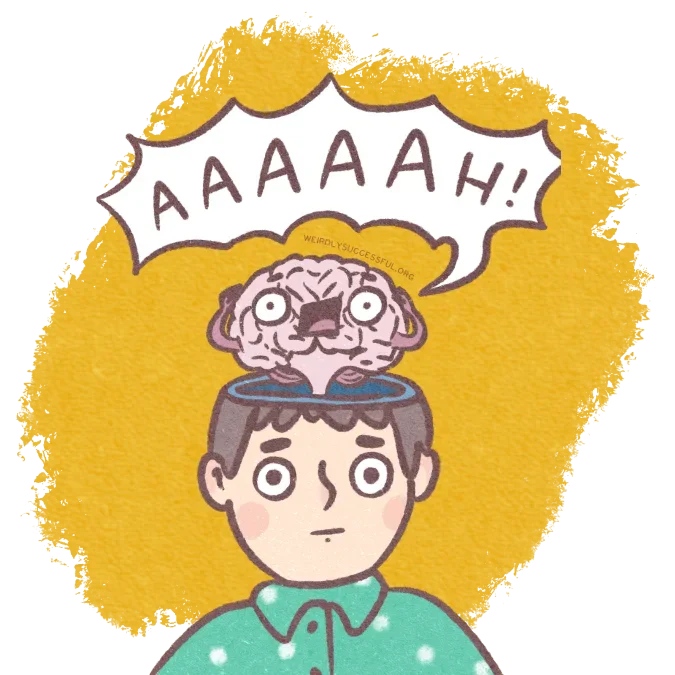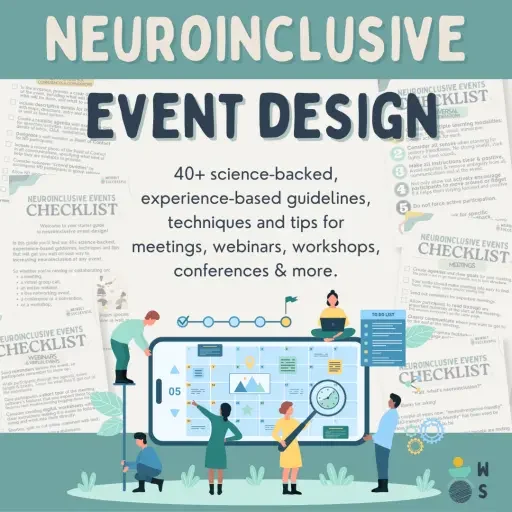A feeling of immense distress, a sensory overwhelm / autistic overwhelm is a strong reaction caused by the compounded effects of stress, exhaustion, lack of safety, a sense of danger, unmet needs, too much information, noise, sights or sounds, smells or touch.
Table of Contents[Hide][Show]
What is autistic overwhelm?
Due to the high number of potential variations in neurodivergence, one’s processing, storage, interpretation, integration and recall of information can all work very differently from the (assumed) neurotypical consensus.
The lower the flexibility and the fewer the accommodations available for someone to conduct their life within these confines, the more distressing it will be just to exist as a neurodivergent person every day.
A neurodivergent person may have:
- a heightened sensitivity to sensory stimuli (lights, sounds, smells, touch)
- lower filtering of stimuli leading to a higher amount of stimuli the brain needs to process at any point in time
- working memory issues affecting short-term and long-term memory storage and recall
- information organisational processes requiring more time and mental energy to integrate new information
- interest-led cognition resulting in variable capacities for self-directing attention and focus
- a lower emotional processing threshold
- a lower stress tolerance threshold
Some traits in this list are commonly associated with autism. Others with ADHD. Some with both. Some crop up in OCD. Some are viewed as temporary in one and ‘there all the time’ in another.
So while it’s common to separate out autistic overwhelm as its own thing, when viewed through a wider neurodivergence framework, ‘neurodivergent overwhelm‘ seems like a more useful moniker.
Why does autistic overwhelm happen?
Overwhelm is not random.
Neurodivergent overwhelm is a result of a combination of neurological effects that can include:
- sensory overload – a combination of all sensory stimuli and differences in habituation, context switching and transitions
- information overload – sudden or large changes in plans, environment or circumstance; lack of spatial awareness or temporal perspective; too much information or social interactions to process; uncertainty from memory issues
- social anxiety from communication & social difficulties
- exhaustion – sleep deprivation, masking, prolonged focus
- a lack of perceived safety – can’t keep up with stimuli & information to process
- medical issues – medication side effects, missed doses, co-occurrent conditions, migraines, period pains, vertigo, nausea

Neurodivergent people can experience overwhelm if their needs are not met and they are not supported properly.
Speaking of sleep deprivation, information overwhelm, sensory overload, period pains, nausea, or just plain stress that we all experience from time to time, this is a good place to mention that neurodivergent traits are human traits.
What makes a person neurodivergent in one aspect of their functioning is the frequency and intensity of experiencing these traits.
Sensory overwhelm can happen more often if you’re already tired or stressed and everything becomes too much – for example in a crowded place, at a loud concert, or after wearing a new jumper that feels itchy on your skin. It is not a tantrum and you are allowed to remove yourself from the situation to regulate yourself.
Not to be confused with panic attacks and anxiety attacks.
What overwhelm can look like: common outward signs of distress
Internalised overwhelm
- shallow breathing
- hunched posture
- muscle tension
- jerky or rigid movements
- staring at a fixed point
- stuttering
- difficulty finding words
- big pauses in speech
- temporary loss of speech (verbal shutdown)
Externalised overwhelm
- intensifying repetitive movements
- heightened emotional intensity
- high volume speech
- vocal outbursts (incl. profanities)
- throwing, hitting, or kicking objects
- spitting, pushing, hitting, biting
- self-directed violence (hitting themselves, head-banging, hair-pulling)
- running off
Note while these lists contain useful indicators, they come with significant caveats.
- Multiple traits indicated in overwhelm appear across neurodivergence, so the presentation of a single trait does not indicate overwhelm on its own. For these traits, the key is the frequency and intensity of the presentation. If you know the person, changes to that person’s own baseline are also good indicators.
- Not only can overwhelm manifest both inwardly and outwardly, but one can precede or shift into the other. This is why autistic overwhelm is often described as if it “came out of nowhere”. But by understanding the interaction of internalised and externalised signs, it becomes clear that ‘bursts’ of externalised signs are many times preceded by a period of internalised signs.
Is this what an autistic meltdown is? What is a shutdown?
A final note on wording.
We came up with internalised overwhelm and externalised overwhelm in an attempt to neutralise the language used around autistic overwhelm.
Colloquially and in most online resources, internalised signs of distress are often referred to as ‘implosion’ and ‘shutdown’, and externalised signs as ‘explosion’ and ‘meltdown’.
Some neurodivergent people are okay with calling their own experience a ‘meltdown’ or a ‘shutdown’, but for many, these are labels that only exacerbate their distress, especially given the historical (and incorrect) conflation of overwhelm responses with ‘temper tantrums’.
For this reason, it’s best to avoid using these when referring to a person in distress unless explicitly consented to as okay.
What’s happening in the brain during an overwhelm experience
Decreased access to:
- long-term planning
- evaluating options
- processing complex information
- a sense of time other than ‘now’
Overtaken by:
- the fight-flight-or-freeze response …leading to the automatic physiological mechanisms that normally activate across the body when a situation is deemed dangerous.
One cause of overwhelm also might be reduced habituation.
A person’s behaviour during an experience of overwhelm is not the same as their intent.
What the experience can feel like: physical pain, complete loss of control, hopelessness, an overload of information, extreme anguish, an overload of all senses, feelings of being in danger.
What the ‘behaviour’ communicates: I am not well. Make it stop.
De-escalation of autistic overwhelm is not a behavioural intervention.
It’s support.
You need to ask yourself:
“How can I help this person in pain?
Related terms
Sensory processing difficulties
Sensory processing difficulties are a group of traits associated with neurodivergence. They’re part of the wider group of sensory processing differences, meaning all the ways neurodivergent brains handle sensory information differently from …
verbal shutdown
Verbal shutdown is a temporary inability to produce speech despite having intact language and thoughts – an involuntary neurological response to overwhelm. It’s when words exist in one’s mind but cannot be physically spoken due to sensory, emotional, …
auditory stimming
Auditory stimming is a natural self-regulatory behavior that involves making sounds with your voice, either through non-word vocalizations (vocal stimming) or speech-based expressions (verbal stimming). This form of stimming helps with emotional …
restriction
Restriction means being prevented from moving freely or being confined against your will. It can include being held down, trapped, or having your movement controlled by others. This is particularly important for neurodivergent people, who have …
decompressing
Decompressing refers to engaging in activities or behaviours that allow a person to relax, unwind, and alleviate stress or sensory overload.
This term is particularly significant in the neurodivergent community as we often experience heightened …
transitions
Transitioning, in the context of neurodiversity, refers to the process of moving from one state, activity, or place to another. It involves a shift in attention, focus, and cognitive resources.
For neurodivergent individuals, it may require …
context switching
Context switching refers to the cognitive process of shifting attention between different tasks or mental states. It involves disengaging from one task and engaging in another, requiring the brain to change its focus, rules, and objectives.
This …
deep pressure
Deep pressure is a natural sensory need where firm, consistent pressure (like heavy blankets or tight hugs) helps tension melt away from your body. Many people naturally seek this through things like snug clothing or curling up under blankets – it’s …
habituation
Habituation is a biological reaction mechanism where if a non-threatening stimuli keeps repeating, the response to it lowers over time. In neurodivergence, the brain’s reduced capacity for habituation means we can’t "tune out" unimportant …
interoception
Interoception is the ability to notice and identify feelings inside one’s body, like thirst or hunger. It also includes the ability to notice and regulate temperature changes or notice pain.
autistic burnout
Autistic burnout refers to a state of physical, mental, and emotional exhaustion experienced by autistic people. It is a result of prolonged exposure to overwhelming sensory, social, and cognitive demands, often in an environment that does not …
Learn more about neuroinclusive event design
Grab our Neuroinclusive Events Checklist – a handy and hyper-condensed guide full of zero- to low-cost tips and techniques for webinars, meetings, networking events and workshops.
Download now from The Library, our free resource hub.



